3d Auxiliary Surgical Group Unit History

Picture illustrating a group of Officers of the 3d Auxiliary Surgical Group (United Kingdom, early 1944).
Activation:
The 3d Medical Command Headquarters & Headquarters Company was constituted 21 December 1928 in the Regular Army as the 3d Auxiliary Surgical Group. Activation took place on 5 May 1942 at Ft. Sam Houston, Texas (the largest Army Post in the continental United States; total acreage 23,592; troop capacity 719 Officers & 24,825 Enlisted Men –ed).
The unit was part of the medical build-up in the British Isles and Detachments served both in the Mediterranean and in the European Theaters. The 3d Auxiliary Surgical Group left the United States 7 December 1942 on board the ‘Queen Mary’. It arrived in Scotland 15 December, leaving Scotland to settle near Oxford where it acted as a complementary Surgical Team being attached at various times to the 77th Station – 121st Station – 231st Station and 12th Evacuation Hospitals. The Group comprised 30 Teams among which 20 general surgical units, 4 neuro-surgical units, and 4 thoracic-surgical units.

Insignia of the 3d Auxiliary Surgical Group. The character was designed by Walt Disney.
Early Operations and Re-organization:
The 3d Aux Surg Gp arrived in the MTO 16 Feb 43 and served in North Africa; Algeria and Tunisia, and the Mediterranean; Sicily . It received the following Campaign credits: Tunisia (17 Nov 42 > 13 May 43) and Sicily (9 Jul 43 > 17 Aug 43). It was transferred to the ETO 11 November 1943. Five Teams of the 3d were flown in as medical reinforcements to II Corps for its operations in southern Tunisia on 18 March 1943. Seven Surgical Teams went ashore with CENT Force on Sicily (Scoglitti landings) on 10 July 1943. Another three Teams supported DIME Force (Gela landings), while nine Surgical Teams landed with JOSS Force (Licata landings).
Casualties handled in the Tunisian Campaign – 943
Casualties handled in the Sicilian Campaign – 1,446
Casualties handled in the European Campaign – 18,885
Although limited, the experience gained in North Africa served its purpose, it taught the men why they were essential, where they should operate, and where they were needed, what equipment was necessary, and how to get organized. As soon as the North African contingent returned to the United Kingdom in November 1943, the entire Group was assigned to First United States Army. In December 1943 plans were drawn, teams were activated, training was extended, and in view of the next big operation, the Invasion of France, Teams were organized for deployment, first in the Clearing Stations on the beach, and later in the Field Hospitals inland. Numerous changes in personnel took place, and before the first eight months of 1944, the Group had had 3 Commanding Officers and 3 Executive Officers.
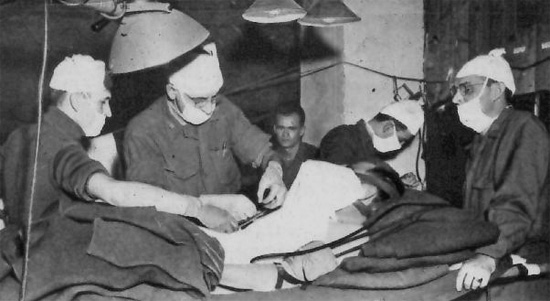
Surgeons operate on a patient wearing ordinary wool uniforms.
| 3d Auxiliary Surgical Group (Commanding Officer) | |
| 1 Jan > 21 Feb 44 | Colonel John F. Blatt |
| 21 Feb > 24 Jul 44 | Lt. Colonel Elmer A. Lodmell |
| 24 Jul 44 > 31 Dec 44 | Colonel Joseph A. Crisler Jr |
| 3d Auxiliary Surgical Group (Executive Officer) | |
| 1 Jan > 24 Apr 44 | Lt. Colonel Harry P. Harper |
| 24 Apr > 22 Aug 44 | Major William F. Maley |
| 22 Aug > 31 Dec 44 | Lt. Colonel Carl C. Francis |
There was considerable turn-over of other professional personnel too. During 1944, 56 Officers left and 70 joined; 36 Nurses left, and 34 joined; the Group had half of the original 119 Officers who left the ZI in 1943.
The two components which had operated separately, one in England, and one in the Mediterranean Theater were reunited in England on 22 December 1943, at Cp. Bewdley, near Stourport, Worcestershire. The main task was now to clarify the status of Teams operating with Hospitals in the field, defining tactical deployment – professional responsibility – functional jurisdiction. Another task was to prepare Teams and individuals for any coming operation, and stress the technical aspects of surgery in the field. Extensive training at base camp and later in the medical units to which the Teams would be attached for D-Day was immediately implemented.
The intention was to use Surgical Teams to support Field Hospitals or other medical units – in this situation, the Team Surgeon assumed the entire responsibility for the surgical treatment and care of the patient (from Admission to Disposition). When the Teams were attached to Evacuation Hospitals – the Chief of the Surgical Service was responsible for the pre-operative preparation of the patient, his selection for operation, and the direction of his post-operative care.
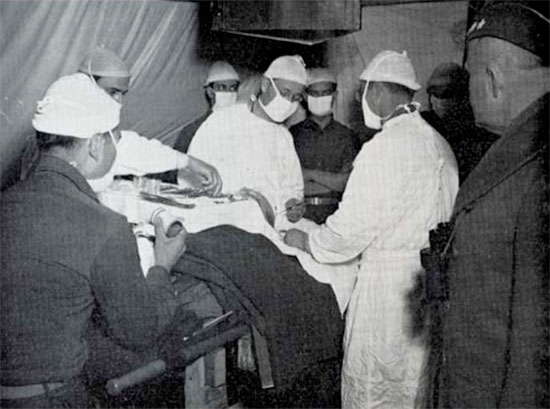
Lt. General John C. H. Lee, CG SOS, ETOUSA, observes a Surgical Team of the 3d Auxiliary Surgical Group as they train for the Invasion of the Continent with FUSA. Picture taken at Pentewan Beach, Cornwall, England, 12 April 1944.
T/O 8-571 dated 13 July 1942 called for 25 general Surgical Teams and an assorted variety of ‘specialty’ Teams, most of them consisting of 3 Officers, 1 Nurse, and 2 Enlisted Surgical Technicians. Such Teams functioned well in Evacuation Hospitals, but no so well in Field Hospitals where the many added responsibilities placed great strain on the auxiliary personnel. Based on past experience (primarily North Africa), the Group was rebuilt into Surgical Teams of 4 Officers and 4 Enlisted Men each, with “North African” and “English” contingents well mixed. Since the majority of the Nurses had never before functioned as Team Nurses (they were usually placed on DS for general relief work), they were trained to function as a responsible group for the operating room of the Field Hospital. It was felt better to attach them to the Hospital than to the Auxiliary Team, making them supervise the OR and the post-operative ward. Constant presence of Nurses would allow for a closer bond between the Hospital and the Auxiliary Surgical Teams. Several Medical Officers with experience in the MTO were detailed to visit Hospitals and help with the standardization of supplies and procedures. Meanwhile, many Officers were instructed to attend short courses at US and British Hospitals, others followed a new anesthesia course at the 120th Station Hospital. Aside from the specific medical training programs, frequent sessions took place in tent pitching, tent repair, motor maintenance, generator upkeep, black out discipline, equipment salvage, and when D-Day came, every Team had at least one man who could handle a truck and two men who could handle a sterile stock table.
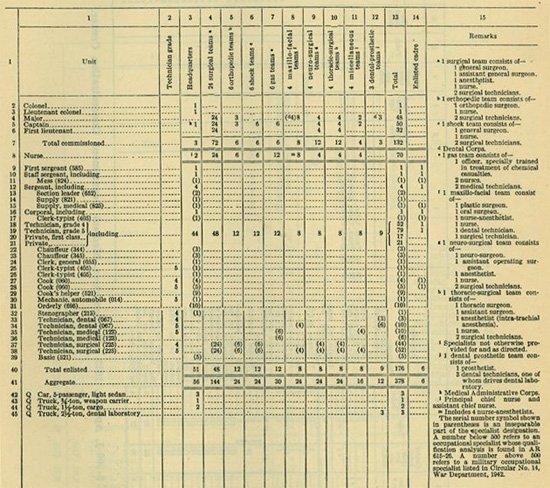
Copy of T/O 8-571, dated 13 July 1942, Organization of the Auxiliary Surgical Group.
Above T/O was amended by WD circular #306 in 1942, thereby reducing the number of Nurses to 64.
Preparations for D-Day:
| Teams 1, 2, 3, 4, 5, and 6 | 261st Medical Battalion – 1st Engineer Special Brigade (Utah Beach) |
| Teams 7, 8, 9, 10, 11, and 12 | 61st Medical Battalion – 5th Engineer Special Brigade (Omaha Beach) |
| Teams 13, 14, 15, 16, 17, and 18 | 60th Medical Battalion – 6th Engineer Special Brigade (Omaha Beach) |
| Team 19 | 307th Airborne Medical Company – 82d Airborne Division (Utah Beach) |
| Team 20 | 326th Airborne Medical Company – 101st Airborne Division (Utah Beach) |
| Teams 21, 22, and 23 | Liaison with Field Hospitals andReserve |
| Teams 24, and 25 | Supervision of Mobile Surgical Units |
| (in view of the risks involved, Teams 19 & 20 were made up of volunteers) | |
Much equipment had to be requisitioned or especially constructed. Carpenters were ordered to build stock tables, sawhorses, and plaster boards. Ordnance people made Mayo stands, IV supports, and taps for running water. Nurses sewed 421 laparotomy sheets, 170 glove containers, 5500 muslin wrappers, 2400 half sheets, and 597 cuffed gowns. Electricians wired overhead reflectors, standby batteries, and malleable lights, while Technicians checked all instruments, autoclaves, and chests. After that loading tables were prepared and based on the limited number of vehicles available to the first assault waves, each item had to be carefully evaluated as to its priority. Chests were packed and repacked until they contained only the absolute essentials. Initial supplies had to be sufficient to outlast a short period of isolation, notwithstanding the limited weight and space allowance. Key equipment would have to be carried in duplicate. All the operating equipment had to fit into a ¼-ton trailer. In addition each man was to carry a canvas field kit containing sterile debridement sets, towels, bandages, tourniquets, drugs, and medical odds and ends, and parachute bundles were expected to be dropped with replenishments. Landing schedules for D-Day consisted of a first glider-borne echelon on the eve of D-Day, a seaborne echelon on D-Day, and a second glider-borne echelon on the night of D-Day.
In order to prepare for the coming Invasion, combined maneuvers (Beaver-Tiger-Fabius I & II-Duck) were held at different periods and at different locations, such as Slapton Sands, the Gower Peninsula, and the Bristol Channel. They involved embarkation, debarkation, and landing on beaches very similar to the ones to be encountered in France, with set up of Beach Clearing Stations and evacuation of simulated casualties. The Teams that would support the air-borne forces went on practice flights in order to become familiar with glider operations.
Toward the middle of May 1944, the Teams went to the marshaling areas where they finalized loading, received their last briefing, and prepared for embarkation. On 1 and 2 June they boarded their respective vessels along the south coast of England, and on 5 June they finally set sail for France…

Illustration showing surgeons operating on a patient in the field.
D-Day 6 June 1944:
Regimental and Battalion Surgeons and medical aidmen of the two Airborne Divisions were the first Medical Department soldiers to set foot in Normandy. They either dropped by parachute or rode in gliders with their respective organizations, or later landed at the beachheads with the seaborne elements. Much of the equipment and many of the people carrying it would get lost, killed, or captured. During the first hours on the ground, medical personnel collected whatever supplies that could be located, they contacted other paratroopers, gave first aid to men injured in the jump or in glider crashes and in the first fire fights with the enemy, and worked their way toward the Battalion Assembly areas. Many elements were scattered and cut off from their original units for days. Care was often improvised and wounded had to be left behind to be captured. Temporary Aid Stations were set up with Medical Officers scavenging for supply bundles and commandeering farm wagons, carts, or even captured enemy vehicles to collect wounded from widespread positions.
The very first Auxiliary Surgical Teams to arrive in Normandy, were those that accompanied the Airborne elements on D-Day.
The different teams worked in four different types of installations:
Beach Clearing Stations
Field Hospitals
Evacuation Hospitals
Field Hospitals acting as Evacuation Hospitals (Sep 44)
The 3d Aux Surg Gp roster for the Normandy operations was as follows:
Team No. 1
Major Allen M. Boyden, Captain Thomas J. Floyd, Captain Arthur F. Jones, Captain Gordon A. Dodds, Tec 4 Chester Houston, Tec 5 William F. Thomas, Pvt John J. Levy, Tec 5 William M. Rogers
Team No. 2
Major Howard W. Brettell, Captain Ralph A. Dorner, Captain John A. Esposito, Captain Frederick Hadden, Tec 4 Aurelio M. DeLeon Tec 5 Charles A. Bonin, Tec 5 Edward M. Pawlowicz, Tec 5 James A. Bowman
Team No. 3
Major Frank Wood, Captain John A. Growdon, Captain Abraham Horvitz, Captain Maurice Schneider, Tec 4 Clarence C. Moody, Tec 4 J. D. Dillard, Tec 5 Melvin J. Cole, Pfc Aldor R. Romillard
Team No. 4
Major Robert M. Coffey, Captain Summer W. Brown, Captain William Selkin, Captain Norman Kornfield, Tec 5 Lloyd L. Kraus, Tec 5 William L. Jansa, Pfc John C. Fritzges, Pvt John T. Kelly
Team No. 5
Major Walter W. King, Major Herbert S. Raines, Captain Nathan C. Plimpton, Captain Harold Gartner, Tec 4 Tommie H. Hicks, Tec 5 Carl W. Hamilton, Tec 5 Thomas J. Giaguzzi, Pfc Julius Polyniak
Team No. 6
Major Glenn W. Zeiders, Captain Ivan Kempner, Captain Drake Pritchett, Captain Max. H. Parrott, Tec 5 Asa Thomas, Tec 5 Wilmer Meidinger, Pvt Charles W. Castro, Pvt Anthony L. Lewandowski
Team No. 7
Major Louis W. Stoller, Captain William R. Ferraro, Captain Elphege A. Beaudreault, Captain Jacob Bernstein, Tec 4 Sam A. Rosenberg, Tec 4 Ralph T. Fritz, Tec 5 Wayne S. Balcom, Tec 5 Harry O. Andrews
Team No. 8
Major John B. Peyton, Captain Hollis H. Brainard, Captain Treadwell L. Ireland, Captain Francis X. DiFabio, Tec 5 John L. Myers, Tec Emery W. Hopkins, Tec 5 Thomas A. Geurink, Pvt William Faskow
Team No. 9
Major Douw S. Meyers, Major Duncn A. Camerob, Captain Myer M. Dashe, Captain Herman Brown, Tec 4 Lawrence E. Lemieux, Tec 5 Lionel J. E. Thibault, Pfc Nick Maravich, Pfc Joseph Scuiletti, Jr.
Team No. 10
Major Reynold E. Church, Major John C. McClintock, Captain George A. Friedman, Captain Frank Merlo, Tec 4 Victor Nigro, Pfc Carl L. Heyd, Pvt Dewey Fee, Pvt Robert C. Emery

Dog Tags issued to Tec 4 Joseph H. Patille of Team No. 11, 3d Auxiliary Surgical Group.
Team No. 11
Major Charles A. Serbst, Major Evan Tansley, Captain Harry Fisher, Captain Eugene F. Galvin, Tec 4 James F. McDonald, Tec 4 Joseph H. Patille, Tec 5 George F. Broerman, Pfc Franklin R. Fisher
Team No. 12
Major James M. Higginbotham, Major Marion E. Black, Captain Herbert Marks, Captain Julius Hersh, Tec 5 Claris W. Dixon, Tec 5 Edward H. Fitzpatrick, Tec 5 Arville E. Shanholtzer, Tec Jan Prys
Team No. 13
Major Darrell A. Campbell, Captain John P. Sheldon, Captain Edwin G. Kirby, Captain Lester W. Netz, Tec 4 Thomas A. Owens, Tec 5 Donald J. Troy, Tec 5 Walter I. Nelson, Tec 5 Edward G. Gibson
Team No. 14
Major Benjamin R. Reiter, Captain Stanley F. Smazal, Captain Rene A. Torrado, Captain Irving R. Hayman, Tec 4 Marion G. Mitcham, Tec 4 Scend W. Anderson, Tec 4 Wesley E. Robinson, Pfc Guy C. Peluso
Team No. 15
Major Robert M. Sutton, Captain Anthony T. Privitera, Captain Warren C. Hastings, Captain Kenneth J. Chadwell, Tec 4 Nicholas Berkich, Tec 5 James C. Fish, Tec 5 David V. Pike, Pfc Lawrence H. Janson
Team No. 16
Major Francis M. Findlay, Captain Walter Twarog, Major Christopher Stahler, Jr., Captain Sidney Simons, Tec 4 Robert J. Smith, Tec 5 Claude W. Thomas, Tec 5 John M. Curran, Tec 5 Clarence C. Merkord
Team No. 17
Major Alfred Hurwitz, Captain Albert W. Brown, Captain Silas A. Coffin, Captain Anthony Noto, Tec 4 George G. Reedy, Tec 4 Marvin R. Wormington, Tec 5 James E. Battles, Pfc William Konikoff
Team No. 18
Major Horace G. Williams, Captain Joseph A. Sapienza, Major Chester K. Barta, Captain Joseph H. Hillman, Tec 4 Stuart J. Garcia, Tec 5 Jay W. Barker, Tec 5 Limuel D. Walton, Pvt Louis Turi
Team No. 19
Major James J. Whitsitt, Captain Michael M. Donovan, Captain Frank J. Lavieri, Captain Wentworth L. Osteen, Tec 4 Lloyd Cooper, Tec 5 Matt A. Rautiola, Tec 5 Daniel Overly, Tec 5 Harold J. Meinz
Team No. 20
Major Albert J. Crandall, Captain John S. Rodda, Captain Charles O. Van Gorder, Captain Saul Dworkin, Tec 4 Allen E. Ray, Tec 5 Emil K. Natalle, Tec 5 Ernest E. Burgess, Pvt Francis J. Muska
Team No. 21
Major Philip F. Partington, Major Sidney Chipman, Captain Ronald W. Adams, Captain Martin R. Mesick, Clifford R. Inman, James R. Netherlands, James R. Feeney
Team No. 22
Major Clifford L. Graves, Major Wilson Weisel, Captain Claude M. Warren, Captain Philip Lief, Tec 4 Wilbur J. McNeeley, Tec 5 Willie P. Jones, Tec 5 Joseph B. Heida, Tec 5 Sidney P. Lenox
Team No. 23
Major Mark H. Williams, Major Robert T. Stoner, Captain Joseph S. Tumiel, Captain Roy A. Geider, Tec 4 Fred Reichers, Tec 4 Cyril Greene, Tec 5 Oneal Gross, Pfc George G. Guido
Team No. 24
Major Paul K. Maloney, Captain William R. Ferraro, Captain Irving H. Rosenthal, Captain Louis Wolfe, Tec 4 Frank E. Jebsen, Tec 4 Wesley E. Robinson, Tec 4 Ray L. Kerns, Tec 5 Boyd W. Lehr
Team No. 25
Major Edwin M. Soderstrom, Captain Philip M. Winslow, Captain Rocco Tella,; Captain Sidney A. Levine, Justice Hill, Harry Hummer, Troy Mitchell, William Lipka
In addition the Group had 2 Neuro-Surgeons, Major Walter G. Haynes and Captain Donald D. Matson; 2 Plastic Surgeons, Major Jacob J. Longacre and Captain George A. Friedman; and 2 Dental Surgeons, Major J. Harvey Bang and Captain Benjamin G. Bauerle, who worked partly as individuals and partly as teams.
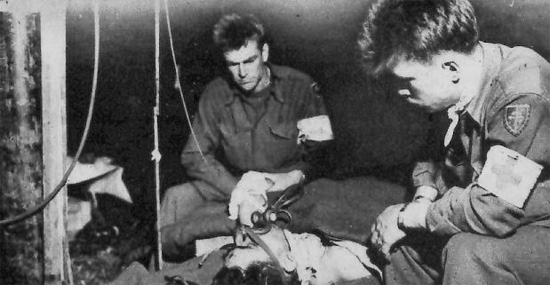
Partial view of an O.R. illustrating medical staff of the 304th Medical Battalion, 79th Infantry Division, at work. Picture taken somewhere in France …
Team 19 was split into three elements: the first wave was to carry the Medical Detachments and the other two were to bring the 307th Abn Med Co. Major James J. Whitsitt, MC, was requested to accompany part of the Division Staff in one of the gliders, and was therefore the first member of the 3d Auxiliary Surgical Group to set foot in France, arriving at H-4 ½ at Blosville. Team 19 remained with the 82d Abn Div during its drive north to Montebourg and then south to Pont L’Abbé in a 36-day campaign which made great demands on their endurance and professional skills.
Team 20 was to accompany the 326th Abn Med Co and already landed with the first wave of glider-borne elements, and was therefore able to start surgery on a full scale from the very start. They had previously selected a farmhouse near Hiesville, where they arrived at H-3, but had to wait for arrival of more paratroopers to overpower the German troops, before being able to set up surgery in the spacious grounds and buildings of Château de Colombières. Major Albert W. Crandall, MC, took charge of the OR and immediately started making the necessary arrangements to handle the many incoming patients. It was no doubt proven that glider-borne Hospital elements were essential for early life-saving surgery in the field, and that Auxiliary Surgical Teams should be part of such an element!
The burden of treating and evacuating First United States Army D–Day casualties fell largely on the organic medical units of the Airborne and Infantry Divisions, the Naval Beach Battalions, and on the Teams of the 3d Auxiliary Surgical Group operating under control of Colonel Charles E. Brenn, MC, (V Corps – Omaha Beach) and Colonel Paul Hayes, MC, (VII Corps – Utah Beach). Subunits, i.e. provisional Collecto-Clearing Companies, pertaining to the Engineer Special Brigades (5th & 6th ESB – Omaha Beach and 1st ESB – Utah Beach) operated with one or two attached Teams of the 3d Auxiliary Surgical Group. To help Evacuation Hospitals overcome their backlog during the D-Day operations, First Army deployed Surgical Teams and mobile truck-mounted Surgical and X-Ray units of the 3d Aux Surg Gp, and, when these proved insufficient, added provisional Teams from ComZ Hospitals that had landed but were not yet operational.
As the Beachheads expanded, First US Army Medical Detachments A and B disembarked respectively at Omaha Beach (8 Jun 44) and Utah Beach (9 Jun 44) on British Hospital Carriers, including Aid Station and Litter Platoons of two separate Collecting Companies, and 6 Teams of the 4th Auxiliary Surgical Group, one Platoon of a Supply Depot Company, Headquarters of a Medical Group, and liaison Officers from various medical and non-medical commands in order to reinforce medical support of the different units in the field.
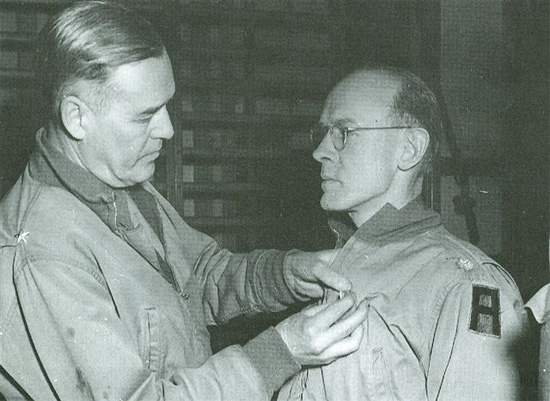
Brigadier General John A. Rogers, FUSA Surgeon, decorates a member of the Medical Corps. Taken in Normandy, 1944.
Teams 1, 4, 5, 6 were distributed among the Companies pertaining to the 261st Amphibious Medical Battalion with Beach Clearing Stations operating on D-Day at Utah Beach. Teams 1 and 6 were transferred from LCI 513 to smaller craft at about H+4 and landed at “Tare Green” Beach in order to support Co C, 261st Med Bn. Teams 4 and 5 transported on board LCI 250 hit “Uncle Red” around H+6 to support Co A, 261st Med Bn. Teams 2 and 3 landed on D+1 at approximately 1700 hours at “Tare Green” to support Co B, 261st Med Bn. On D+2 an appropriate system of shifts was in effect, allowing the team members to briefly rest before resuming work, while staying with Clearing Stations for approximately one week, and then joining the Field Hospitals.
Teams 13, 14, 17 and 18 aboard LST 351 landed at Omaha Beach, in support of the 634th Clearing Station, 60th Medical Battalion. All 4 teams were transferred to a Rhino ferry offshore, together with elements of the Clearance Company and the 29th Infantry Division. They all landed on “Easy Green” on D+1 around 0800 hours, except for Team 17 which disembarked at “Dog White” Beach around 1000 hrs. The major task consisted in assisting at the 1st Infantry Division Clearing Station and help set up the 634th Clr Sta.
Teams 7, 8, 9, 10, 11, 12, 15, 16 were split over the three provisional Collecto-Clearing Companies of the 61st Medical Battalion, landing over a two-mile strip ranging from “Dog Green” to “Easy Red”. Team 11 on board LSI(L) Empire Anvil almost landed at the wrong (British) Beach, but still made it to “Easy Green” on H+5 and started helping the 391st Clr Sta. Teams 7, 9, 10, and 12 reached “Easy Red” around H+7 after transferring from AP-67 Dorothea Dix onto LCTs to join the beach and start supporting the 392d and 393d Clearing Stations. Teams 8, 15, and 16 aboard the Empire Anvil landed at about H+11 at “Dog Red”, and also went in to support the 391st and 393d Clearing Stations.
On the night of D+1, the British Hospital Carrier Naushon arrived off Omaha Beach with Detachment A. It brought the CO, the Neuro-Surgeon, and 6 Teams of the 4th Auxiliary Surgical Group with them. These men first worked on board ship for the first twelve hours and only went ashore at 1000 hours on D+2. Another British Hospital Carrier Lady Connaught came in on D+2, landing at 2300 hours at Utah Beach with Detachment B, including 6 more Teams of the 4th Auxiliary Surgical Group. The 3 Reserve Teams 21, 22 and 23 arrived on board the Princess Maud and after transferring to the vessel’s LCAs, landed at 1700 hours at Utah Beach on D+4. These Surgical Teams spent almost the entire day at the Clearing Stations, several days at some of the Field Hospitals, and the rest of the month at the Evacuation Hospitals. The last two parties landing at Omaha Beach were Headquarters and Teams 24 and 25 which reached the Beachhead on board the LSI(L) Empire Lance on D+16. All the Nurses also came in the same day, and after a few days, they joined the Field Hospitals too. On D+22, the 3d Auxiliary Surgical Group’s motor convoy (consisting of 5 mobile surgical units and 3 mobile x-ray units, with another 3 mobile dental units added later) arrived off Utah Beach with the Liberty Ship Charles D. Poston, and after debarkation was over, the mobile units could finally get to work.
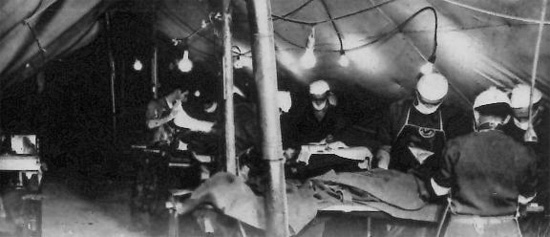
Surgical teams perform numerous operations in a Field Operating Room set up in a Hospital Ward Tent.
From the D-Day operations it was apparent that while conditions on the Beaches varied from comparative calm at Utah to extreme tumult at Omaha, the Auxiliary Surgical Teams nevertheless performed well. The Clearing Stations were behind schedule in setting up their installations, and at least on Omaha Beach, the Teams went in at a time when they could hardly function in a proper way, due to the horrible tactical situation. Basically the idea to have early surgery on the Beaches was a sound one although the Clearing Stations did not possess proper conditions for major surgery. On the Beach, however, it became a matter of necessity and the Teams did their task properly and professionally, operating almost a thousand patients before arrival of the regular Hospitals!
After the Normandy Beachhead breakout (July-August 44), it became SOP to attach a Field Hospital Platoon to each Divisional Clearing Station, and to augment them with general Surgery and Shock Teams from an Auxiliary Surgical Group whenever necessary. When Evacuation Hospitals became overworked with a constant flow of casualties, Army Surgeons reinforced them with Teams from Auxiliary Surgical Groups and inactive General Hospitals. Auxiliary Surgical Teams also augmented organic medical units during operations in which the wounded could not be readily evacuated to the rear. During large offensive operations, such as Overlord, Market-Garden, and Varsity, definitive surgery took place much further forward than previously believed possible – this time the Surgeons accompanied the soldiers to save their lives if wounded!
| 3d Auxiliary Surgical Group Stations in France (under Tentage) | ||
| 22 Jun > 24 Jun 44 | Bivouac | St. Laurent-sur-Mer |
| 24 Jun > 16 Jul 44 | Bivouac | Cricqueville-en-Bessin |
| 16 Jul > 05 Aug 44 | Bivouac | Lison |
| 05 Aug > 19 Aug 44 | Bivouac | Canisy |
| 19 Aug > 26 Aug 44 | Bivouac | Le Lassay |
| 26 Aug 44 > 02 Sep | Bivouac | Senonches |
| 02 Sep > 05 Sep 44 | Bivouac | Voisin |
| 05 Sep > 14 Sep 44 | Bivouac | La Capelle |
Further Operations:
The rapid advance of the Allied Armies allowed the Group to reach the border with Belgium around mid September 1944. At first, because of the frequent moves, the Group continued to bivouac in the field, but from 28 September on, buildings were used. In Baelen, Belgium it was a somber schoolhouse; in Spa, an elegant villa; and in Huy, a grim ‘pension’…
| 3d Auxiliary Surgical Group Stations in Belgium | ||
| 14 Sep > 16 Sep 44 | Bivouac | Ouffet |
| 16 Sep > 28 Sep 44 | Bivouac | Herbestal |
| 28 Sep > 26 Oct 44 | Schoolhouse | Baelen |
| 26 Oct > 18 Dec 44 | Villa | Spa |
| 18 Dec > 31 Dec 44 | Pension | Huy |
With only slight variations, the following Teams were available in the European Theater during WW2:
| General Surgical Teams | 26 |
| Neuro-Surgical Teams | 2 |
| Maxillo-Facial Teams | 1 |
| X-Ray Teams | 3 |
| Dental Prosthetic Teams | 3 |
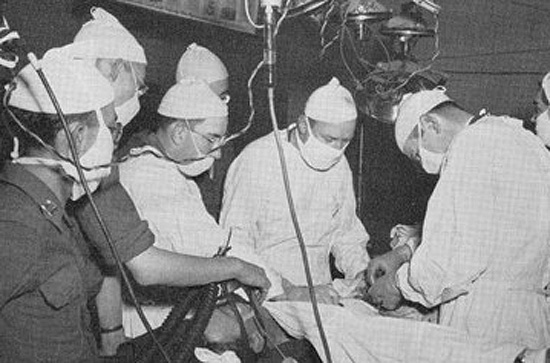
Members of an Auxiliary Surgical Team operate and assist personnel of a Field Hospital Platoon, somewhere in the E.T.O.
In July and August 1944, while the front was still contained, additional medical units arrived in France without however being able to go into action right away. Their Officers were therefore made up into Surgical and Shock Teams, placed at the disposal of the First Army, and distributed by the 3d Auxiliary Surgical Group among the various Hospitals. As such, the Team roster on 31 July, read 29 Surgical Teams from the 3d Auxiliary Surgical Group, 47 Surgical Teams from the 4th Auxiliary Surgical Group, and 8 Surgical Teams from the 1st Auxiliary Surgical Group.
By end of 1944, The European Theater of Operations had available five complete Auxiliary Surgical Groups, attached to the various Field Armies and Army Groups, and the equivalent of half of another, assigned to ComZ. Each Group included 25 Teams of Doctors, Nurses, and Enlisted Technicians, organized for general surgery – neuro-surgery – maxillo-facial surgery – x-ray – and dental prosthetics. The Teams contained an impressive array of professional medical talent, and the Theater took great pains to maintain the quality of their personnel.
When the Ninth United States Army’s 5th Auxiliary Surgical Group arrived in France with a substantial number of young, inexperienced Medical Officers, the Army restaffed them with better qualified men transferred from ComZ. Besides the Teams, the Auxiliary Surgical Groups included varying numbers of truck-mounted mobile Operating Rooms and X-Ray facilities, designed for temporary expansion of busy and overburdened Hospitals. Auxiliary Groups normally attached most of their general Teams, heavily weighted with thoracic and abdominal specialists to Field Hospitals, while maxillo-facial and neuro-surgical specialized Teams went to assist Evacuation Hospitals.
| Auxiliary Surgical Groups in WW2 | |
| 1st Auxiliary Surgical Group | European Theater of Operations |
| 2d Auxiliary Surgical Group | Mediterranean Theater of Operations |
| 3d Auxiliary Surgical Group | Mediterranean Theater of Operations European Theater of Operations |
| 4th Auxiliary Surgical Group | European Theater of Operations |
| 5th Auxiliary Surgical Group | European Theater of Operations |
Additional Notes:
The Auxiliary Surgical Group was developed within the Surgical Consultants Division of The Office of The Surgeon General, US Army. The ASG was designed as a surgical reserve to be allocated at 1 per Field Army with the aim to augment Field and Evacuation Hospitals.
The Surgical Consultants Division handpicked Surgeons based on their medical experience. Basically each Group consisted of 61 four-to-six persons Teams in general, orthopedic, maxillo-facial, neurological, and thoracic surgery, and also treatment for shock.
The 1st Auxiliary Surgical Group served in the ETO during WW2. It supplied Teams to the 3d Auxiliary Surgical Group after D-Day, which remained under control of the latter during most of the campaigns in Europe. In the latter part of October 1944 another 6 Teams were transferred to reinforce the 3d Auxiliary, they were subsequently sent to assist the medical personnel of some Evacuation Hospitals. Special Teams of the 1st Aux Surg Gp served under the XVIII Airborne Corps in September 1944 – under Seventh US Army in November 1944 – fought in the Bulge in December 1944 – and supported the 17th Airborne Division in March 1945. The Group came under control of Fifteenth US Army on 18 April 1945 (total casualties handled 10,469).
The 2d Auxiliary Surgical Group had the longest experience of any of the Groups. It already served in North Africa in November 1942 – and in Sicily in July 1943 – it then fought with the Fifth US Army in Italy – participated in the Invasion of Southern France in August 1944 with the Seventh US Army – and continued assisting the US Forces from the Riviera to the Moselle – passing from Mediterranean to European Theater control in December 1944 (total casualties handled 22,000).
Teams from the 3d Auxiliary Surgical Group initially supported II Corps in North Africa and Sicily in 1943 – before being reunited with its other contingent stationed in the United Kingdom in December 1943, in view of the preparation for Operation Overlord. It then mainly served with the First US Army, fighting in France, Belgium, Holland, and Germany, with Teams on the ground during Operation Market-Garden, and another one being surrounded in Bastogne, during the Battle of the Bulge (total casualties handled 25,000).

Schematic representation of evacuation of casualties in an Army zone.
Teams of the 4th Auxiliary Surgical Group served in France, Belgium and Germany. Some Teams already assisted the First US Army during the Invasion of Normandy in June-July 1944 – then served under the Third US Army as soon as it became operational on 1 August 1944. Two Teams were flown into Bastogne on 26 December 1944 to provide badly needed medical support. Another 2 Teams landed by glider during Operation Varsity, March 1945, in support of the 17th Airborne Division (total casualties handled 17,222).
The 5th Auxiliary Surgical Group was assigned to the Ninth US Army around mid-1944. Some of its Teams had had previous battle experience when serving with the Fifth US Army in Italy, and for a short period with the Third US Army in France (total casualties handled 15,000).
Awards
Meritorious Service Plaque
(for superior performance of duty in the accomplishment of exceptionally difficult tasks
during the period from 1 May 1944 to 31 July 1944)
The authors are still looking for additional data relating to field operations conducted by the 3d Auxiliary Surgical Group, while providing medical support to United States Army Forces later in World War 2. This would help them complete the unit history of the Group. Special thanks should go to Sheryl A. Scissons, daughter of Tec 5 Wayne S. Balcom (ASN: 16042874) a Veteran of Team No. 7 who served with the Group in Normandy during D-Day. Sheryl generously shared a number of historical data with our Staff.
